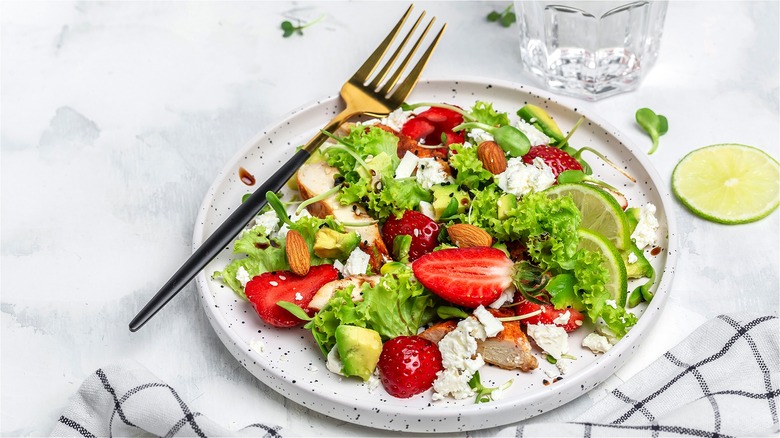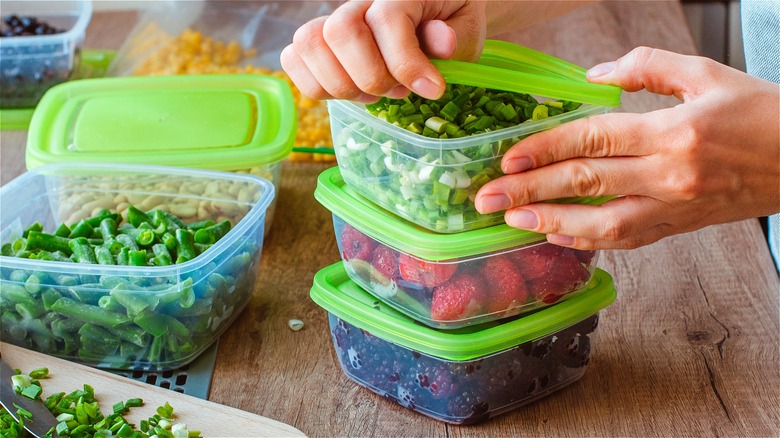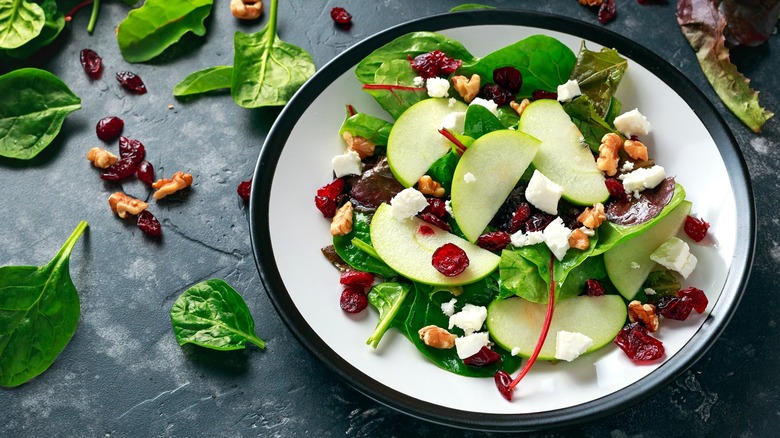Why Is Fruit Ruining Your Salad (And How To Fix It)
There are obvious differences between making a juicy bowl of fruit salad and infusing Mother Nature's candy into your next platter of spring greens. Excess juice isn't so much of a problem when you're eating a bunch of chopped fruits at once, but fruit's added moisture can wreak havoc on firm and crisp lettuce leaves. Even though utilizing a variety of produce on your next salad will upgrade its overall flavor and visual appeal, most fruits are loaded with moisture. Fruits range between 75% to 95% water and most are relatively acidic. While these water-centric foods make salads extra fresh-tasting, if you want your next produce-heavy meal to last more than an hour or two, consider how and when to properly add fruit to your salad mix.
To avoid creating a wilted sloppy mess, your best bet is to drain moisture-heavy fruits before adding them to your salad bowl. Fruits like oranges and pomegranate arils can be prepared and left to drain for 5 to 10 minutes over a colander in your sink. Canned fruit lovers should also make sure to remove any included juice. When adding fresh berries, make sure they're completely dry before slicing and adding to your salad. While these tips are essential, if you want your salad to keep for a longer period, add fruit to greens right before consumption.
The best way to incorporate fruit into your next green salad
To build the ultimate salad, you need to use your taste buds and think logically about how certain ingredients impact your meal's resulting flavor and texture. Preparing a mixed salad with all your favorite fruits may affect the taste of your dressing and the consistency of your salad over an extended period of time. Prepare fruit and store sliced portions in individualized containers ahead of time. Don't add sweetened produce to greens until serving for the most flavorful, texture-rich result. If fruit-dressed salad is prepared too far in advance, this might impact the flavor of your greens or change the consistency of other added ingredients like nuts or cucumber slices. Keeping sliced fruit in separate containers until ready to eat ensures all included flavors remain pure and concentrated.
If you want to add fruit to your next salad platter and don't know where to start, let the flavors of the current season guide you. Use fresh berries in the spring and summer, apples in the fall, and citrus in the winter. While you can find a way to incorporate any fruit into a hearty bed of greens, you may want to avoid fruits with an extremely high level of moisture. Watermelon and strawberries have over 90% water. If you choose these fruits for your next salad, don't add them until mealtime.
Creative ways to use fruit in salad without compromising texture
For those worrying about compromising their salad's consistency, there are more ways to add fruit besides incorporating raw sliced produce. Explore the world of dried fruit by making cranberry-feta salad or upgrade a classic bed of greens with a handful of raisins. If you love using fresh berries but want to avoid the necessary washing and slicing, try dried blueberries or cherries. For an extra bit of crunch, add freeze-dried strawberries or raspberries upon serving. However, note that salad dressing will eventually soften any freeze-dried fruit additions.
Next to imbuing your salads with safer, low-moisture toppings, you can also amp up your salad dressings with pureed fruits and vegetables. As long as you have a trusted blender, get creative. Try a raspberry vinaigrette with pulverized berries or a mango chili dressing with fresh mango chunks. You can also make a great homemade dressing with your jam jar. Add a few extra ingredients to your next dwindling jar of residual jam, shake, and enjoy a bright and flavorful salad dressing in no time. There are plenty of unique ways to add fruits' sweet and subtle flavors to your next salad. Yet for a tasty salad made with raw produce, drain off excess juice and avoid assembling this fresh meal until serving.


